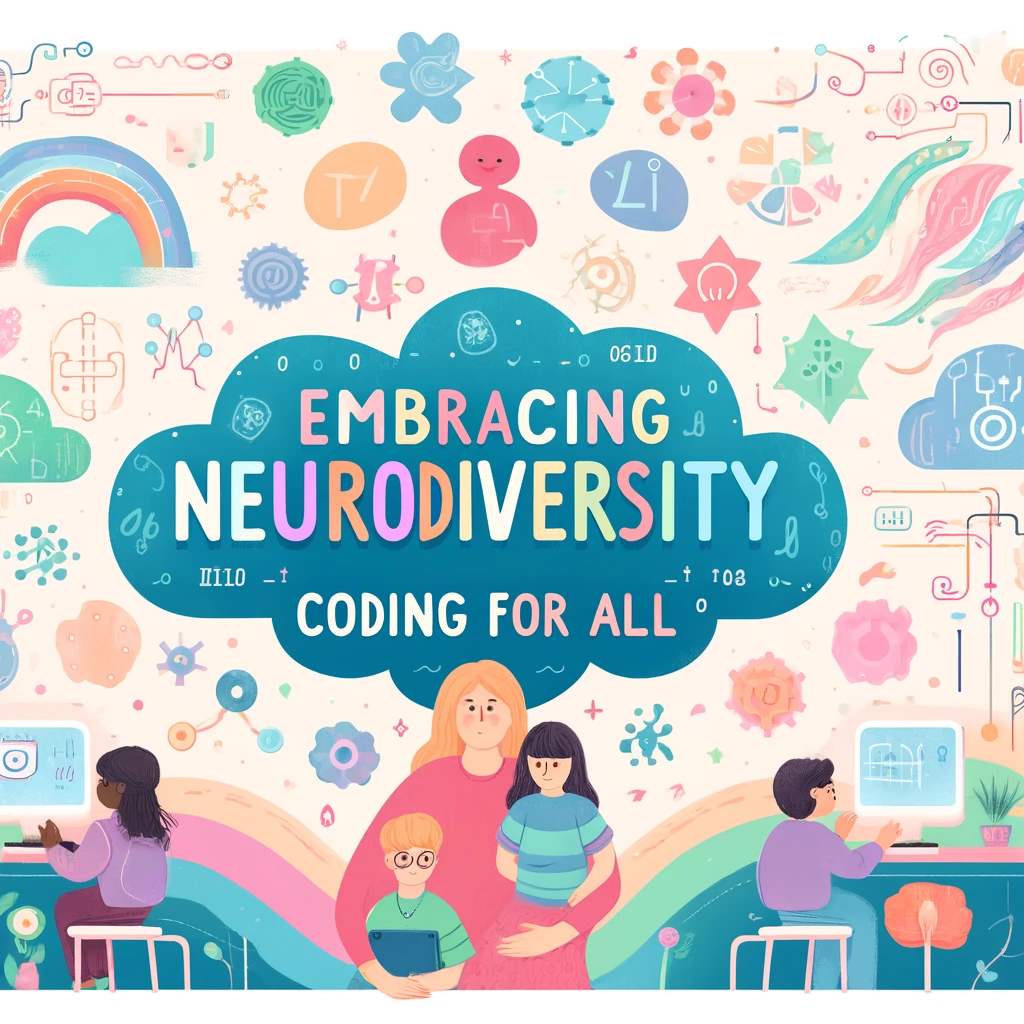Teaching is not just a profession; it is a calling, a mission, and a passion. For me, this calling has led me on a remarkable journey as a coding teacher to an extraordinary group of students—my spectrum kids. These children, with their unique abilities and perspectives, have transformed my understanding of teaching and learning, revealing the beauty of diversity in the classroom.
Embracing Neurodiversity in Coding
Neurodiversity is the concept that variations in the human brain regarding sociability, learning, attention, and mood are normal and should be acknowledged and respected. My spectrum kids, who are on the autism spectrum, embody this diversity. They approach coding with a freshness and creativity that often astounds me. Their unique ways of thinking have taught me that there is no one right way to solve a problem. With an understanding of neurodiversity as our foundation, let’s explore the teaching techniques that can effectively engage and support spectrum kids in learning to code.
Teaching Techniques: Beyond the Parson Problem
Teaching coding to these children requires patience, empathy, and a willingness to adapt. Traditional teaching methods often need to be modified to fit their learning styles. Here are some techniques I find particularly effective:
- Visual Aids and Step-by-Step Instructions:Visual aids are crucial in making coding concepts more accessible. I use diagrams, flowcharts, annotations and color-coded instructions to break down complex ideas into manageable steps. Step-by-step instructions help my students follow along and understand the sequence of tasks.
- The Parson Problem:This educational tool involves giving students a jumbled set of code lines and asking them to arrange these lines in the correct order. This method helps break down complex coding tasks into more manageable steps and enhances their understanding of coding logic and structure.
For example, this is a simple game – “Pop the Ballon” ,when you click on the colourful ball, it counts up by 1, makes a popping sound, and then disappears.


Benefits of the Parson Problem include enhanced logical thinking, a focus on syntax and semantics, incremental learning, and increased engagement and fun.
3.Dealing with Behavioural Issues: Spectrum kids can sometimes exhibit behaviours that disrupt the learning process. I address these issues with a calm and understanding approach. Establishing a routine, providing clear instructions, and using positive reinforcement are key strategies. I also create a quiet space where students can go if they feel overwhelmed.
Celebrating Small Victories
One of the most rewarding aspects of teaching my spectrum kids is witnessing their moments of triumph. These victories might seem small to some, but to us, they are monumental. The joy on a child’s face when they successfully debug a piece of code or create a simple game is indescribable.

These moments boost their confidence, enhance their problem-solving skills, and open up new avenues for self-expression.
Examples of Small Victories
- Debugging Success: When a student who struggled with a persistent bug finally solves it, the joy and satisfaction they feel is immense. It’s not just about fixing the code; it’s about overcoming a challenge and proving to themselves that they can do it.
- Creating Projects: Watching a student complete their first project, whether it’s a simple game or a digital art piece, is incredibly fulfilling. These projects often reflect their creativity and individuality, and finishing them gives students a sense of accomplishment.
- Classroom Recognition: We celebrate these victories in the classroom, too. Acknowledging a student’s hard work and success in front of their peers helps build a supportive community and encourages others to strive for their own victories.
Creating an Inclusive Learning Environment
Creating an inclusive learning environment is essential in my classroom. This means more than just providing the necessary tools and resources; it’s about encourage a culture of acceptance and understanding. Each student is unique, and their needs vary widely.

Here’s how I create an inclusive environment:
- Individualized Learning Plans: I develop individualized learning plans that cater to each student’s strengths and weaknesses. This ensures that every child can progress at their own pace and receive the support they need.
- Accommodating Diverse Needs: Providing quiet spaces for students who need a calm environment to focus helps them manage sensory overload and anxiety. Allowing extra time for assignments and tests ensures that students who process information more slowly are not left behind.
- Encouraging Peer Support: Encouraging collaboration on group projects develops a sense of community and helps students develop social skills. Pairing students with peer mentors can provide additional support and create a buddy system that enhances learning and social interaction.
- Promoting a Culture of Acceptance: Using positive reinforcement to celebrate achievements, big or small, helps build a positive classroom atmosphere where students feel valued and supported.
The Power of Technology as an Equalizer
Technology has the incredible power to level the playing field for students with different abilities. Coding, in particular, offers a platform for my spectrum kids to excel. It allows them to focus on logic and structure, areas where many of them shine. Here’s how technology acts as an equalizer in my classroom:
- Personalized Learning: Many coding platforms, including SkoolofCode, offer adaptive learning paths that adjust to each student’s pace and level of understanding. This personalized approach ensures that every student can progress at a comfortable rate, receiving support when needed and advancing when ready.
- Visual and Interactive Tools: Tools such as interactive coding environments and simulators allow students to see the immediate results of their code. This real-time feedback helps them understand the cause-and-effect relationship in coding, making abstract concepts more concrete.
- Accessibility Features: Many coding platforms allow customization of the user interface to suit individual needs. This can include adjusting font sizes, color schemes, and keyboard shortcuts to accommodate visual or motor impairments. Assistive technologies such as speech-to-text and text-to-speech can support students who have difficulty with typing or reading.
- Empowering Creativity: Coding projects allow students to explore their interests and express their creativity. Whether it’s designing a game, building a website, or creating an app, these projects provide a sense of ownership and accomplishment.
How Coding Helps Kids on the Spectrum
Coding can be particularly beneficial for children on the autism spectrum. Here’s how:
- Structure and Predictability: Coding offers clear rules and predictable outcomes, providing comfort through routine and order.
- Logical Thinking and Problem-Solving: Coding enhances these skills, leveraging spectrum kids’ strengths in understanding systems and patterns.
- Focus and Engagement: The interactive nature of coding captures attention and provides immediate feedback, helping maintain focus.
- Creativity and Self-Expression: Coding allows for creative projects, enabling spectrum kids to express their unique perspectives.
- Confidence and Independence: Completing coding tasks boosts confidence and fosters independence, translating to other life areas.
- Social Skills and Collaboration: Collaborative projects offer opportunities for social interaction and teamwork, improving social skills.
The Role of Parents
Parents play a crucial role in the success of their children, especially when it comes to learning something as challenging as coding. They provide the support, encouragement, and resources needed for their children to thrive.

Here’s how parents contribute significantly to the learning journey:
- Support and Encouragement: Parents’ encouragement and praise can boost their children’s confidence and motivation to tackle challenging coding tasks. Creating a conducive environment at home for coding practice can greatly enhance learning.
- Communication and Collaboration: I maintain an open line of communication with the parents of my spectrum kids, keeping them informed about their child’s progress and challenges. Collaborating with parents on strategies to support learning at home ensures that the skills and concepts taught in class are reinforced.
- Resources and Tools: Ensuring that children have access to computers and the internet is vital for practicing coding at home. Parents can also explore online coding classes for kids platforms like SkoolofCode to find additional learning resources.
- Behavioral and Emotional Support: Parents’ understanding of their child’s unique needs and behaviors helps in creating personalized learning strategies. Emotional support from parents can help children overcome frustration and develop resilience.
Right Age for Coding: Children on the Spectrum
The right age for a child on the autism spectrum to start learning coding can vary widely depending on the child’s individual abilities, interests, and readiness.

Here are some guidelines to help you determine the right time:
- Interest and Motivation: If your child shows an interest in computers, games, or logical puzzles, this could be a good indicator they might enjoy and benefit from learning to code.
- Cognitive Development: Around ages 7 to 10, many children begin to develop the cognitive skills needed for basic coding concepts. However, some children on the spectrum might be ready earlier or later than this range.
- Communication and Social Skills: If your child can follow instructions, understand cause-and-effect relationships, and has basic problem-solving skills, they may be ready to start coding. Coding can also be a great way to develop these skills further.
- Tools and Programs: Many programs are designed to introduce coding to young children in an engaging and accessible way. Tools like Scratch, Blockly, and Code.org offer visual programming environments suitable for beginners and can be particularly appealing for children on the spectrum due to their visual nature and straightforward logic.
- Support and Environment: Ensure that your child has a supportive learning environment. This could include access to special education resources, a patient instructor, or a tailored curriculum that considers their unique learning style and pace.
- Trial and Observation: Start with small, simple activities and observe your child’s response. If they show enthusiasm and understanding, you can gradually introduce more complex concepts. If they seem frustrated or disinterested, it might be worth revisiting the idea later.
- Consult with Professionals: If you are unsure, consulting with educators, therapists, or specialists who work with children on the spectrum can provide personalized advice and guidance.
Ultimately, there is no one-size-fits-all answer, and the key is to be responsive to your child’s individual needs and readiness. Starting with fun and interactive coding games can be a great way to gauge their interest and aptitude before moving on to more structured learning.
SkoolOfCode: A Supportive Platform
SkoolOfCode has been a transformative partner in my journey as a coding teacher for spectrum kids, offering a fun, interactive, and accessible learning experience that aligns perfectly with my teaching methods.
- Personalized Learning Experience: SkoolOfCode provides a tailored learning experience that adapts to each student’s pace and level of understanding, preventing frustration and keeping students motivated. This personalized approach is particularly beneficial for spectrum kids, allowing them to progress comfortably.
- Engaging and Interactive Tools: The platform’s interactive tools, such as coding environments, simulations, and gamified elements, make learning to code engaging and enjoyable. These features provide immediate feedback, helping students understand coding concepts more concretely.
- Project-Based Learning: Emphasizing project-based learning, SkoolOfCode encourages students to work on coding projects that align with their interests. This approach enhances coding skills, promotes creativity, and provides a sense of accomplishment.
- Collaborative Environment: The platform facilitates collaboration among students, allowing them to work together on coding projects regardless of location. This structured environment helps spectrum kids practice communication and cooperation skills.
- Comprehensive Support and Resources: SkoolOfCode offers a wealth of resources, including practice task and coding challenges, to support both students and teachers. The platform also provides tools to track progress and tailor instruction, ensuring comprehensive support.
- Parental Involvement: Recognizing the importance of parental support, SkoolOfCode offers resources to help parents create a conducive learning environment at home and support their child’s coding journey.
Early Success Stories
Several of my students have already shown remarkable progress and potential. One student, who initially struggled with basic commands, recently created a fully functional game. Another, who found it difficult to focus, developed an app to help other children manage their time and tasks. These achievements are just the beginning, and I am excited to see where their skills will take them.
Conclusion
Being a coding teacher to my spectrum kids is more than a job—it’s a privilege. It’s about recognizing and celebrating the unique strengths and perspectives of each child. It’s about creating an inclusive environment where every student can thrive. And most importantly, it’s about believing in the limitless potential of every child, regardless of their abilities.
As educators, parents, and community members, we all have a role to play in embracing neurodiversity and fostering environments where every child can succeed. Let’s commit to enhance an inclusive environment where every child, regardless of their abilities, can succeed. Join me in championing neurodiversity in our classrooms and beyond.
Book a trial class with SkoolOfCode today, and let your child explore coding under the guidance of experienced instructors. Let’s work together to unlock your child’s creative potential and inspire a passion for technology and innovation.
Ms.Manpreet Virk, an educator at SkoolOfCode with a degree in M.Phil and Master in Computer Science. She is passionate about learning and teaching young minds.

